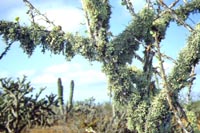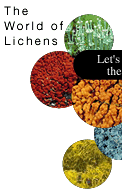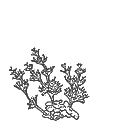 |

Lichens are members of fungi. They are characterized by forming symbiosis
with algae. When a fungus forms a symbiotic organism with an alga, it creates
a peculiar body called "thallus". Fungi (mycobionts) and algae
(photobionts) that compose lichens help each other to survive. In return
for the stable housing and water supply that the fungi provide to the algae,
the mycobionts receive nutrition (carbohydrate) that the algae produce
by photosynthesis.@Their symbiosis is so tight that its shape, physiological
function and distribution are genetically inherited just like an independent
plant.
Lichens are widely distributed all over the world. In Japan alone, more
than 1800 species are known to exist. They normally grow around us, but
since many of them are vulnerable to air@pollution and slight changes in
their habitat, they are rapidly withdrawing from big cities. However, away
from those urban areas, in forests and high mountains, we can see lichens
beautifully covering the surface of the earth and rocks and tree trunks.
 |
fig.1:
Lichens in the Sonora Desert, Mexico |
‘Plants
easily mistaken as lichens
| |
 Lichens Lichens
|
 |
Hepaticae
and mosses |
 Fungi Fungi |
| Body
cell |
Cells
of fungi and algae |
Cells
containing chroloplast |
Hyphae
without chroloplast |
| Shape |
No
clear distinction between stems and leaves
Crustose, fruticose, and foliose thalli |
Clearly
defined stems and leaves
Cormus , thallus |
Without
leaves or stems
Forms mass of hyphae (mycelium), mushrooms,etc. |
| Color
|
Mostly
gray or light green, exceptionally orange |
Greenish |
Varied
Yellowish ocher
Brown, etc.
Or colorless |
How
they
reproduce |
By
ascospores, soredia, isidia |
Mainly
by spores |
By
spores, pycnoconidia, etc. |
| Classification |
The
fungi (symbiotic organisms with algae or cynobacteria) |
Green
plants |
The
fungi |
|
|
 |




 Lichens
Lichens

 Fungi
Fungi